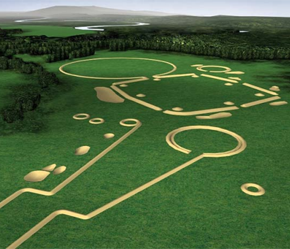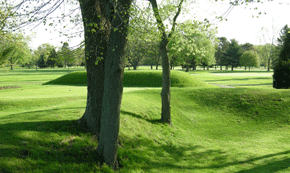The Ancient Ohio Trail

Southern Ohio presents one of the largest concentrations of American Indian monumental earthworks in the world, including vast geometric figures, hilltop enclosures, and animal effigies. Many of these monuments can be visited today, still evident among the historic small towns and back roads of the region. These massive works of architecture are the legacies of varied Native cultures, constructed between 5 and 25 centuries ago. The scale and sophistication of the earthworks, spread out over hundreds of miles, makes the resource very challenging to interpret to residents and visitors
To tell this story on a landscape scale, the owners and interpreters of these sites have developed the Ancient Ohio Trail . This heritage tourism initiative links together the major sites of the earthworks and provides a content rich web site of maps, photographs and computer reconstructions that bring to life each of these complex landscapes. The project is built upon prior work by the Center for the Electronic Reconstruction of Historical and Archaeological Sites (CERHAS) at the University of Cincinnati, who created many of the interactive video exhibits now running at museums and visitors centers throughout the state. Funded in part by the National Endowment for the Humanities, these exhibits feature digital reconstructions and visualizations of the sites (“as they existed in the imaginations of their builders” – Roger Kennedy’s wonderful phrase); plus interpretive voices from many disciplines and perspectives including those of Native Americans; and vivid landscape-based interface designs that invite audiences to “explore” the virtual sites and “discover” their details and meanings. The Ancient Ohio Trail now includes a mobile version, allowing site visitors to experience this rich content while touring the earthworks themselves. The major sites along the trail include:

Fort Ancient near Cincinnati, is one of the world’s preeminent earthen hilltop enclosure: three miles of sinuous walls enclose a hundred acres, opening at 67 stone-lined gateways in various complex designs. The site overlooks a narrow, wooded gorge of the Little Miami River, and can be explored via many hiking trails. The walls are followed by a necklace of man-made ponds, and enclose a perfect square of stone mounds aligned to sun and moon rises.
Serpent Mound in Adams County, is the world’s greatest earthen animal effigy. It slithers across its undulating hilltop with three perfect coils, an elegant spiraling tail, and an elaborate head formation that points directly at the summer solstice sunset. The cliff beneath echoes the serpent’s form with a jutting rock as a “head”.
Newark and Mound City are large Hopewell period complexes near Chillicothe. These earthen structures represent the culture’s elaborate funeral practices and artistic achievements – the apparent center of a cultural heartland with extensive ties to most of North America around AD 200-300.

The Ancient Ohio Trail is a collaboration of all the major owners, managers, and interpreters of Ohio’s primary earthwork sites: The Ohio Historical Society, The US National Park Service, The Arc of Appalachia Preserve System, The Dayton Society of Natural History, the Newark Earthworks Center at The Ohio State University – Newark, and the Center for the Electronic Reconstruction of Historical and Archaeological Sites (CERHAS) at the University of Cincinnati. The National Endowment Humanities provided major funding, with significant in-kind resources from all partners.
Today four of the Ohio earthwork sites are on the United States Tentative List for UNESCO World Heritage nomination: Serpent Mound, the Newark Earthworks, Fort Ancient, and Hopewell Culture National Historical Park at Chillicothe. Although the United States participation in the World Heritage program is at risk, the consortium of partners are hopeful that the nomination of these significant sites can move forward.
Many thanks for information on the Ancient Ohio Trail from John E. Hancock (Cincinnati) and Richard Shiels (Newark) who serve as the Project Co-Directors.


